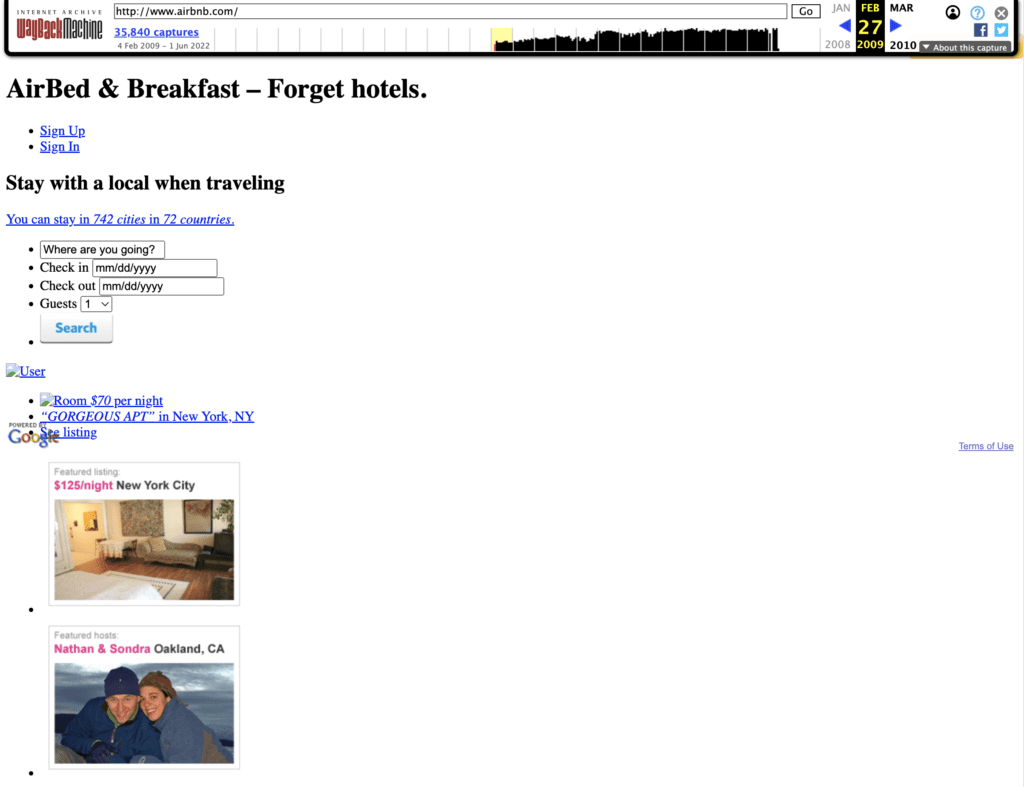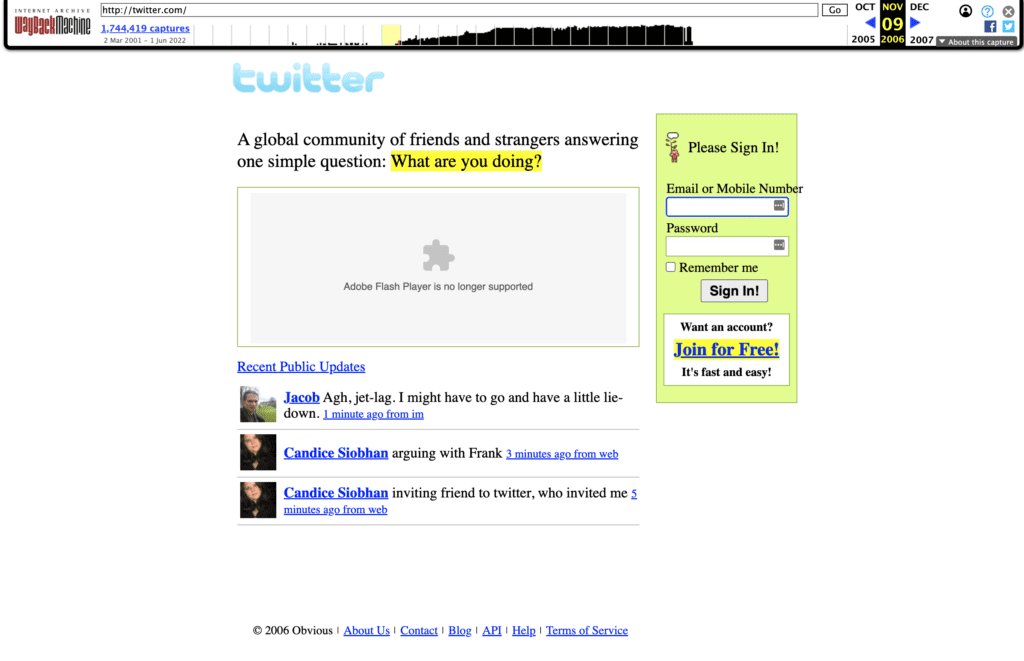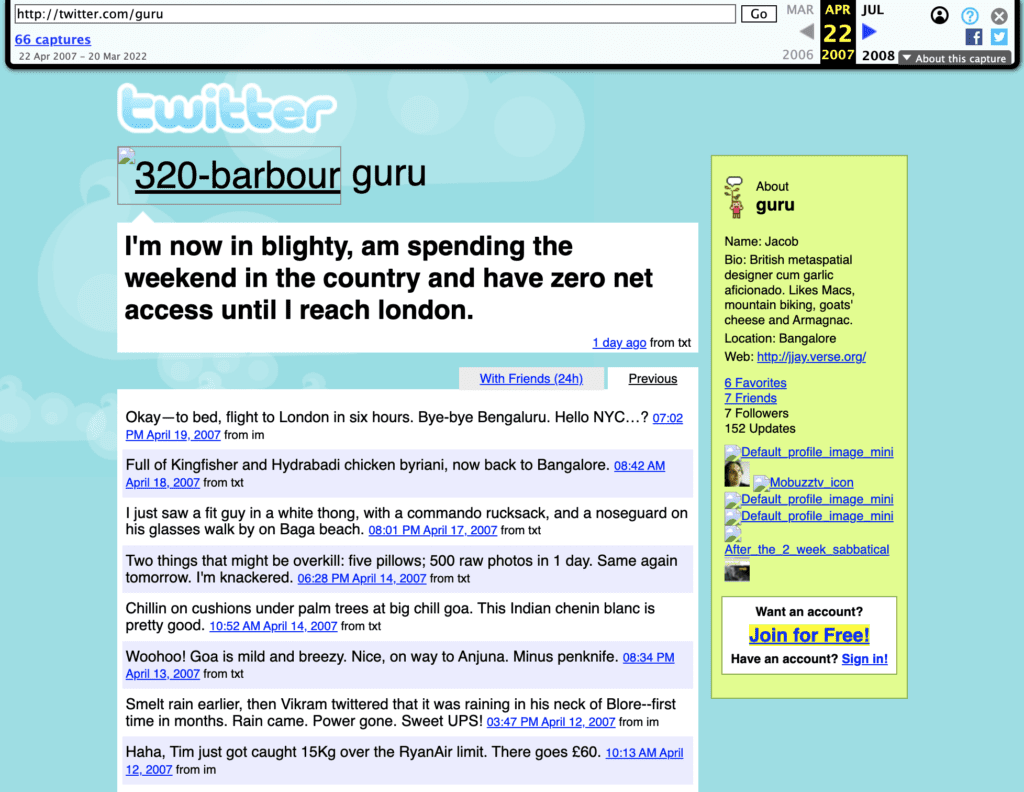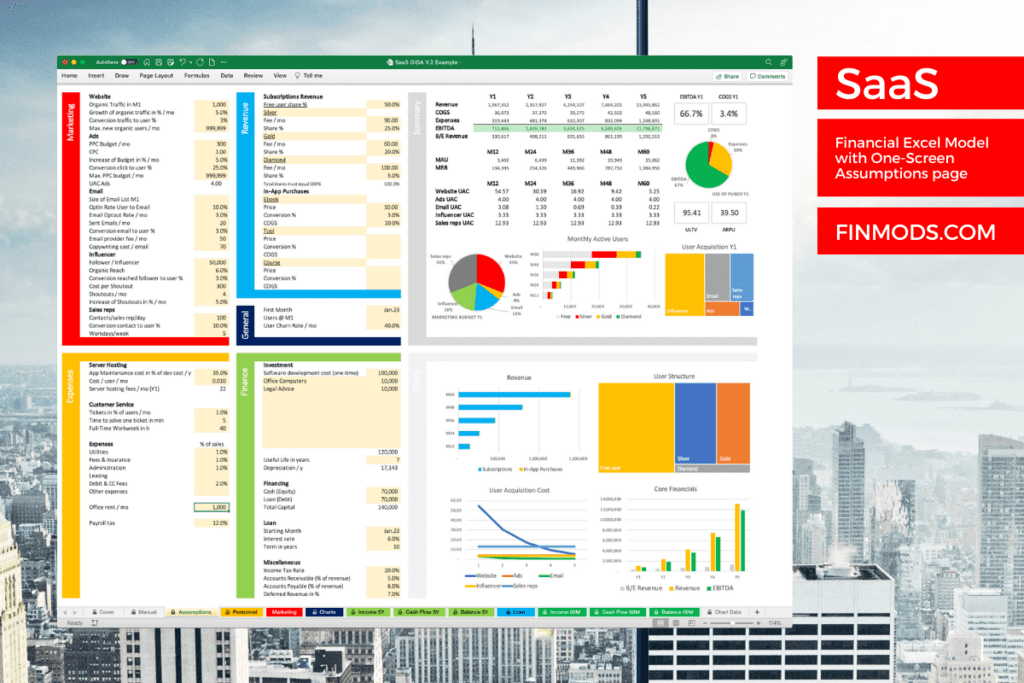If you have a startup idea, you may be tempted to build the perfect product right out of the bat. But is this really the best way? And how did other successful businesses start? Let´s start with a look at some famous examples:
AirBnB
The start of AirBnB was far away from perfect. Have a look at their landing page in February 2009. They only offered four search criteria: destination, check-in date, check-out date, and the number of guests. That was it. There were no payments and no map view and they started with a part-time CTO.

In November 2006, Twitter had very little in common with its version of 2022. The only focus was a global community of friends and strangers answering one simple question: What are you doing!


Amazon
In 2022, Amazon is the world’s largest retailer with sales of $470B and a capitalization of over $1T. But this wasn´t always so. The initial website of 1994 was pretty ugly, had nothing in common with today’s layout, and only provided books at a low price.
These examples clearly show that successful companies usually start with a massively stripped-down version and only discover what works through trial and error. If you want more such examples, check out the startup stories of Dropbox, Buffer, Groupon, or Facebook.
So, let´s dive deeper into the art of creating an embarrassing but valuable MVP.
- AirBnB
- Amazon
- What is an MVP and Why is it Important?
- What are the Disadvantages of Immediately Building the Final Product?
- What are the Benefits of an MVP?
- What´s the Purpose of an MVP?
- MVP Principles: Fast and Cheap
- The Benefits of Speed and Budget
- The MVP Development Process: Design, Build, and Test
- Conclusion

What is an MVP and Why is it Important?
An MVP, or Minimum Viable Product, is a product with just enough features, that delivers value and satisfies early customers. It’s built in a way that allows for rapid iteration and learning based on user feedback. The goal of an MVP is to test assumptions about the product and its potential market as quickly and cheaply as possible.
There are different schools of thought about what constitutes an MVP. Some people believe that it should be something that can be released to the public, while others think it should be something that’s just ready enough for beta testing. The important thing is that the MVP meets the specific needs of the customer segment you’re targeting.
The point of an MVP is to learn as much as possible as quickly as possible. You’ll want to track how users interact with the product and get feedback on what they like and don’t like.
What are the Disadvantages of Immediately Building the Final Product?
There are a few key disadvantages to immediately building the final product, rather than first building a minimum viable product (MVP). The first is that it can be more expensive. Without an MVP, you may end up building features that no one wants or needs. This can lead to a lot of wasted time and money.
42% of startups fail because there is no market for the offered product or service, which makes it the most common reason for failure. Skipping the MVP means increasing the risk of building a product, that nobody needs.
Building a new product is a creative and chaotic process. Multiple team members may have different ideas, which can fragment scarce resources and increase the risk of failure. An MVP can give orientation to all those involved and pool their strengths.
Starting with the final product can cause long product roadmaps, which can frustrate and overwhelm the startup team.
Additionally, it can be difficult to get accurate feedback from users if you haven’t built an MVP. They may not be able to provide clear feedback about what they want or need if they haven’t seen a working version of the product.
Finally, it can be more difficult to make changes and updates to the product once it’s been built. If something isn’t working, you may not be able to change it without rebuilding the entire product.
What are the Benefits of an MVP?
There are many benefits to creating an MVP. First, it allows you to test your assumptions about the market and the product. You can get feedback from your target customers about whether they would be interested in what you’re building and how they would use it.
Second, it helps you focus on the most important features and eliminate anything that’s not essential. This makes your eventual product release simpler and more effective.
Third, it enables you to get to market faster by releasing a product that’s just good enough rather than waiting until everything is perfect.
Fourth, it allows you to collect data about how customers are using your product so you can continue to improve it over time.
What´s the Purpose of an MVP?
An MVP typically has just enough features to be used by early adopters and to provide feedback that can help inform future development. A SaaS MVP might include only the most basic functionality, such as login, sign-up, and profile creation.
A simple landing page with an email opt-in can do the MVP job too. You can present your idea, explain the benefits and features, show some mockups, and offer an email opt-in form, that serves as a waiting list for prospects. When you get people to sign up for the waiting list, you sold them on your idea.
So, one of the main purposes of an MVP is to validate the idea.
MVP Principles: Fast and Cheap
When building an MVP, it’s important to focus on speed and affordability. This will help you get your product to market quickly and reduce costs.
There are a number of ways to achieve these goals, such as using templates or pre-built components, outsourcing development, and using low-cost hosting providers.
Another key factor is to keep the scope of your MVP as small as possible while still including the most important features and functionality.
By following these principles, you can create a minimum viable product that meets your needs while keeping costs and timeframes to a minimum.
The Benefits of Speed and Budget
The first benefit is that it allows you to test your assumptions about your software quickly and cheaply. If your assumptions are wrong, you can find this out quickly and change course before you invest too much time or money in the project. Additionally, building an MVP quickly and cheaply allows you to get your software to market more quickly, which can give you a competitive advantage. So, speed and budget are your best friends, as they reduce risk and provide a competitive advantage.
The MVP Development Process: Design, Build, and Test
The MVP development process is a strategy from software development that helps you build and test a minimum viable product. The MVP development process has three steps: design, build and test. In the design step, you create a prototype of the product. In the build step, you create the product. In the test step, you test the product to see if it meets your requirements. Let´s have a deeper look into this topic.
Step 1: How to Design an MVP
To design an MVP, a company must first identify the essential features of its product. These features can then be used to create a prototype or early version of the product. Keep in mind, that the MVP is just the starting point. Keep it lean, build it fast and focus on the needs of a small group of users.
The MVP should be designed to test these essential features and determine if they are valuable to customers. The MVP can then be used to gather feedback from customers and improve the product before it is released to the public.
Problem
The MVP design process should start with the problem. Define the Problem you want to solve.
- Who has the problem?
- What problem will the product solve?
- Is it effective?
Solution
When you have determined the problem, you can work out a solution, that solves the targeted problem.
Core Features
The solution will dictate the essential features. Consider the MoSCoW Approach and focus on the must-have features. Delete or postpone should have or could have features.
Blueprint
Find the simplest and cheapest way to build your MVP. Write down a blueprint on how you will build it and add a timeline to keep yourself accountable.
Step 2: Tools to Build an MVP
The internet is still young and the digital transformation offers tremendous opportunities for startups. Sometimes, you can take a proven concept from one customer group, change messaging and packaging, add one cool feature and you can provide a completely new solution to another group of users.
Building your MVP isn´t as difficult as it was some years ago. If you are a software developer, you have a huge competitive advantage. But you don´t even have to know how to code. Today, you can profit from multiple no-code solutions, that provide a platform for MVPs and even more sophisticated products. You could even start with a no-code template, that you can adapt to your needs quickly and cheaply. Sounds cool! Isn´t it?
Here are seven tools to consider when building an MVP:
WordPress
WordPress is a content management system that helps developers to create websites and applications. The system is based on PHP and uses a MySQL database. It can be used to create simple or complex websites. On June 1st, 2022, there were 59,303 free plugins and 9,630 free themes available, that allow you to build an amazing website with cool features in no time.
To publish a website you need web hosting. I have been using Bluehost for quite a while and this website also runs on a Bluehost server. As a happy customer, I highly recommend Bluehost for many reasons: Their 24/7 customer support is amazing. Their web servers are super-fast. You get a free domain for the first year. You can publish unlimited websites in one account. You get free email accounts, and you can start at $2.95 per month.
Excel and Airtable
Excel and Airtable templates can help streamline the process of creating invoices, building databases, tracking expenses, and managing other financial tasks. As they are extremely popular and as there are endless use cases, Excel and Airtable (Airtable Referral Link) are great platforms to build an MVP.
Figma
Figma is a software development tool used to create interactive 3D graphics. It allows developers to create characters, objects, and environments quickly and easily. Figma also includes built-in physics and animation tools, making it easy to create realistic motion and interaction. You can use Figma also to create a professional-looking mockup or prototype.
Bubble
Bubble is a no-code platform that allows users to create and manage their own applications without any coding experience. The platform is designed to be user-friendly and easy to use, making it perfect for those who want to create an application but don’t know how to code.
Check out these 73 proven startup ideas, that you can build with a no-code Bubble template from Zeroquode!
Buildfire
Buildfire is a mobile app builder that enables users to create and design their own mobile applications without any programming knowledge. The platform offers a wide range of features and tools that allow users to customize their apps to their specific needs. In addition, Buildfire also provides users with templates and designs that can be used to create professional-looking applications.
AppGyver
AppGyver is the world´s first professional no-code platform, enabling you to build apps for all form factors, including mobile, desktop, browser, TV, and others. And the best thing is, that it´s completely free until you reach sales of $10M.
Video Tip: Michael Seibel [YC] – How to Plan an MVP
Step 3: How to Test an MVP
Interviews
Interviews are a great way to get feedback about an MVP. In order to do an interview, you need to identify people who would be willing to answer your questions. Once you have a list of people, you need to come up with questions that will help you determine whether or not your MVP is successful. You can then use the feedback from the interviews to make changes to your MVP.
Polls
One way to poll about products is to create a survey that asks people about their thoughts on a product or how likely they are to buy it. This type of polling can help companies understand what products people are interested in and whether they think a product is worth investing in. To create a survey, you can use online tools like Survey Monkey or Google Forms.
Email Opt-in
Testing an MVP with email opt-ins on a landing page is a process of verifying the hypotheses that underlie the MVP. You could create a landing page that only presents a mockup and collects email addresses from potential users. Or, you release a working MVP that already provides value and observe how many people sign up for the email list.
Crowdfunding
Testing an MVP with crowdfunding is a great way to get feedback from potential customers and investors. By putting your product or service up for crowdfunding, you can generate interest in your product and see if people are willing to invest in your idea. This can help you determine whether or not to move forward with the development of your product.
Pre-Sales
Testing an MVP with pre-sales is a great way to get feedback from customers who are interested in the product. This allows you to gauge interest in the product and get feedback on what features customers are most interested in. It can also help you determine pricing and how much demand there is for the product.
Selling the MVP
The MVP can be tested by selling it to customers. The MVP should be compared against a mockup version or another version of the product to research the impact on sales. Additionally, surveying customers can help determine if the MVP meets their needs.
Conclusion
An MVP is an important step in the process of developing a new product. By keeping things simple and focusing on the most essential features, you can get your product to market quickly and start gathering feedback from your customers.
So if you want to learn more about startups, join my free newsletter!



Peter is a solopreneur in Salzburg, Austria, a husband, and a family father. He runs a little publishing company, and blogs about starting and running online businesses. In his spare time, he enjoys hiking with friends and reading the Bible, and sometimes he takes a trip in his roaring old black 2001 Jaguar XJ8.





